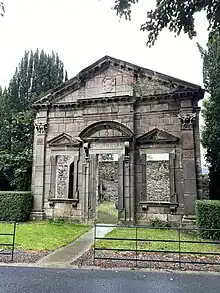Drumcondra House
Drumcondra House is a Georgian house and gardens in Drumcondra, Dublin, Ireland which as of 2022 forms part of the DCU All Hallows Campus and formerly part of All Hallows College. It was designed by the architects Sir Edward Lovett Pearce and Alessandro Galilei and was built in 1726 for Marmaduke Coghill who had originally lived in Belvidere House, and now forms part of DCU St. Patrick's Campus Drumcondra.
| Drumcondra House | |
|---|---|
.jpg.webp) Drumcondra House facade in September 2023 | |
 | |
| Alternative names | Woodlock Hall |
| General information | |
| Status | University Administration Building |
| Type | House |
| Architectural style | Palladian |
| Address | Grace Park Road, Drumcondra, Dublin 9 |
| Town or city | Dublin |
| Country | Ireland |
| Coordinates | 53°22′16″N 6°14′57″W |
| Construction started | 1710 |
| Renovated | 1727 (South facade) |
| Technical details | |
| Floor count | 3 |
| Design and construction | |
| Architect(s) | Edward Lovett Pearce (1727), Alessandro Galilei |
| Developer | Marmaduke Coghill |
| References | |
| [1][2] | |
History
The lands on which the house were built originally formed part of the holdings of the Priory of All Hallows until the dissolution of the monasteries.
The area around the house later came into the ownership of the Coghill family.
Marmaduke Coghill built Drumcondra House near to his the family's older residence at Belvedere House, Drumcondra sometime around the year 1710. He lived there with his sister Mary until his death; the house was renowned for its gardens.[3]
Close by Drumcondra Church (formerly Clonturk parish) was built by Mary Coghill and contains a statue to her brother Marmaduke by the Flemish sculptor Peter Scheemakers. On her death in 1755, the house was left to their niece Hester Coghill, daughter of Marmaduke's brother James.
Drumcondra House became the residence of Charles Moore, 1st Earl of Charleville, following his marriage to Hester in 1737. Following Moore's death in 1764, she remarried a second husband Major John Mayne, who assumed the name of Coghill, and was created a baronet, Sir John Coghill, 1st Baronet of Richings.[4]
The house was then leased from Hester, Countess of Charleville to Alexander Kirkpatrick, a Scottish linen merchant, a former Sheriff of Dublin City in 1783 and governor of the Bank of Ireland. On his death in August 1791 the lease reverted to the Coghill family once again.[5]
The Countess had died in 1789 with most of her estates going to her nephew. Drumcondra House was however left to Sir John Thomas Coghill, 2nd Baronet (1766–1817).
In the early 1800s, John Claudius Beresford lived for a period at the house following his financial difficulties which resulted in a move from his property at 9 Buckingham Street.[6]
Sir Guy Campbell and Lady Campbell, daughter of Lord Edward FitzGerald, were the last residents in the house under the ownership of the Coghill family.
In 1842 Drumcondra House was rented by a Catholic priest named Father John Hand[7] who went on to found a seminary All Hallows College there, which was run by the Vincentian order which is now a college of Dublin City University.[8] £100 was donated towards the site by Lord Mayor of Dublin, Daniel O'Connell.[9] He was buried in the temple in the grounds after his death.
Building
The main house is an eleven-bay three-storey building and appears to have been built sometime after 1710. Edward Lovett Pearce is said to have added the southern face around 1726-27 while Allesandro Gallilei likely also had some input. The later elements include the striking Portland stone features including corinthian pilasters and platband which contrast with other darker calp stone and granite used in construction.[10]
Temple

A temple folly in the grounds of the house was also likely designed by Alessandro Galilei and was constructed around 1730.[11][12][13]
External links
References
- "1726 – Drumcondra House, Dublin". Archiseek - Irish Architecture. 20 February 2012. Retrieved 29 July 2021.
- "CO. DUBLIN, DUBLIN, GRACE PARK ROAD, DRUMCONDRA HOUSE Dictionary of Irish Architects -". www.dia.ie.
- "Design - Lovett Pearce, Edward (Sir)". Victoria and Albert Museum: Explore the Collections. Retrieved 8 September 2021.
- History of Clonturk Fairview Marino History.
- "Alexander KIRKPATRICK, ,of Drumcondra,Donacomper,County Kildare ,Ireland b. 1 Aug 1714 d. 17 Aug 1791 Drumcondra House, Dublin, Ireland". kirkpatrickaustralian.com. Retrieved 25 September 2023.
- Campbell, John P. (1940). "Two Memorable Dublin Houses". Dublin Historical Record. pp. 141–155. Retrieved 25 September 2023.
- The Missionary College of All Hallows (1842-1891) Archived 14 November 2017 at the Wayback Machine by Kevin Condon CM, All Hallows College, Dublin.
- Drumcondra Houses Archived 5 June 2011 at the Wayback Machine Dublin Public Libraries.
- "Fate of All Hallows College mirrors 'collapse of vocations'". The Irish Times. Retrieved 25 September 2023.
- "All Hallows College (Drumcondra House), Grace Park Road, Dublin 9, DUBLIN". Buildings of Ireland. Retrieved 19 January 2022.
- "1720 – Temple, Drumcondra House, Dublin". Archiseek - Irish Architecture. 29 February 2016. Retrieved 4 August 2022.
- "All Hallows College, Grace Park Road, Dublin 9, DUBLIN". Buildings of Ireland. Retrieved 4 August 2022.
- "An Italian in Ireland". The Irish Aesthete. 11 February 2019. Retrieved 4 August 2022.